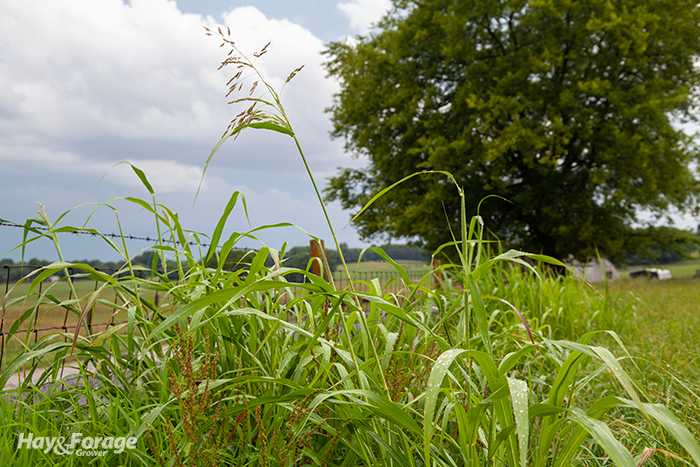
Is it beneficial or is it harmful?
Could it be both?
It’s always been interesting that a few forage species garner a wide range of opinions. People often either love them or hate them for good or not so good reasons. The three species that most often fall into this category are johnsongrass, reed canarygrass, and crabgrass, but there are others.
Johnsongrass
Spreading by both rhizomes and seeds, johnsongrass resides on many states’ noxious weeds list. It is extremely competitive and can quickly overtake a field or pasture if left to its own devices. These days, many livestock producers choose to keep johnsongrass populations to tolerable levels rather than eliminate the species, which has become difficult to impossible.
Johnsongrass has some desirable forage characteristics. In grazing and palatability studies at the Noble Research Institute in Ardmore, Okla., johnsongrass was shown to be a preferred species by grazing yearling steers.
The forage quality of vegetative johnsongrass ranges from 10% to 14% crude protein and 55% to 60% total digestible nutrients (TDN). This competes favorably with other warm-season species such as bermudagrass.
Pastures that are continuously grazed often won’t have any johnsongrass because cattle tend to preferably overgraze the species. Johnsongrass is a species that doesn’t tolerate frequent and low grazing because its growing point is 4 to 8 inches above the soil surface.
If johnsongrass is to be used as a forage resource in times of short feed supplies, such as during drought conditions, it needs to be grazed between 6 and 18 inches. Once the species matures and develops a seedhead, forage quality drops rapidly and cattle will avoid the older tillers. Further, johnsongrass is a prolific seed producer; intentional grazing management will keep additional seeds from being added to the soil.
Aside from its overly competitive nature, johnsongrass has some other negative qualities that deserve attention. It is high on the list of prussic acid (hydrogen cyanide) producers under stressful growing conditions. Johnsongrass also can accumulate toxic levels of nitrates.
Reed canarygrass
Similar to johnsongrass, reed canarygrass also reproduces by rhizomes and seeds. It can take over and dominate a wetland, choking out more desirable plant species.
Reed canarygrass has also been faced with the deserved stigma of having a high alkaloid content. Depending on type, alkaloid compounds reduce palatability and/or cause diarrhea. Animal performance has been negatively correlated with alkaloid concentration.
Despite the negative characteristics associated with native reed canarygrass, farmers have found ways to utilize the species during periods when marshy areas dry out as the growing season progresses into summer and fall. Often, these areas are grazed, or the overly mature plants are cut, dried, and baled for feed or bedding.
Forage agronomists and breeders have long recognized the desirable characteristics of reed canarygrass as a forage resource. It tolerates a wide soil pH range, has outstanding persistence, provides better than average forage yields, tolerates any type of cutting schedule, and thrives in both dry and wet soil conditions.
Improved varieties of reed canarygrass have been developed over the years that have a low alkaloid content and enhanced dry matter production with adequate nitrogen fertilization. When cut or grazed prior to seedhead emergence, these varieties provide a high-quality, dependable forage resource.
Crabgrass
It’s debatable whether crabgrass should be on this list. It’s difficult to find too many negatives for this forage species, but its reputation as nothing more than a weed species persists. This latter opinion might be true for lawns or row-crop fields, but as a pasture component that appears and thrives during mid-summer, it’s hard to beat.
R.L. Dalrymple at the Noble Research Institute developed and released the Red River crabgrass variety in the 1980s. This was later followed by the development and release of the Quick-N-Big variety in 2006, which is still widely used today.
A prolific seed producer, an initial stand of crabgrass will reappear for summers to come if it is allowed to reseed at some point during the growing season. Sometimes a reduced seeding rate can be used to bolster production if stands become too thin.
Crabgrass is also a warm-season species that has a wide range of adaptability and is often the preferred species by cattle in a mix of pasture grasses. Research trials with cattle have shown good performance with crabgrass pastures, and its forage quality is excellent compared to many other warm-season grasses.
In the vegetative stage, crabgrass can tout protein concentrations of 15% to 20% and maintains a low fiber content. It’s superior to bermudagrass in this regard.
